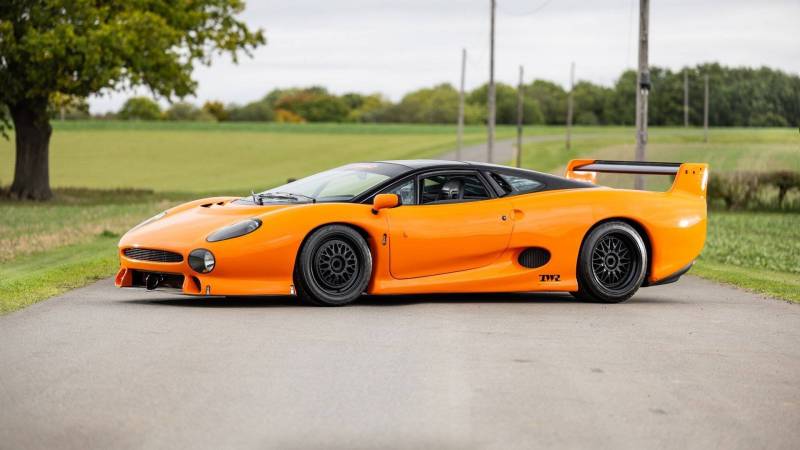Jaguar XJ220S
Production: 1994
Production Type: Limited Edition
Produced: 6
Jaguar XJ220S is a version of the car designed for public roads. It was based on the racing version of the XJ220C for homologation purposes.

About Jaguar XJ220S
If the Jaguar XJ220 was the fastest production car in the mid-nineties, then the TWR supercar, based on the Le Mans racing version, had to be even better than its predecessor.
Compared to the standard XJ220, the TWR version had a new composite body, a more powerful engine, and the vehicle's weight was also reduced as much as possible.
It was originally developed back in the mid-80s. The first display of the finished XJ220 Concept was shown at the Birmingham exhibition in 1988.
The car was supposed to be all-wheel drive and equipped with a 6-liter V12 engine. After the presentation of the car, about 1,500 people were interested in purchasing this innovative vehicle.
In 1991, when the XJ220 entered production, it was discovered that the V12 engine had been replaced by a V6, and all-wheel drive had to be abandoned.
Investors did not really like such innovations, and many decided to return their deposits, which had an extremely negative impact on the company as a whole. In order to somehow get out of this situation and take a break from the problems that had piled up, Jaguar decided to start developing the XJ220C, which will take part in the 24 Hours of Le Mans race.
In January 1993, Tom Walkinshaw Racing (TWR) and Jaguar Sport introduced the XJ220C to compete in the GT (Group N) class of FIA motorsport. At the same time, they announced that the XJ220S, a limited production road version, met homologation requirements. It was Britain's most radical supercar.
The XJ220S supercar was built in 1994. The installed engine with a volume of 3498 cm³ develops a power of 680 horsepower, which allows the car to accelerate to 100 kilometers per hour in 3.3 seconds and reach a top speed of 368 km/h.
While the standard XJ220 was clad in a lightweight aluminum body, the TWR version replaces all panels except the doors with carbon fiber. In doing so, they added a front splitter, wider rocker panels and an adjustable rear spoiler, giving the car a commanding presence and making the standard XJ220 tractable on the road.
Overhauled to 680 hp, TWR pushed the twin-turbo V6 to its limits. Combined with the weight reduction, which removed the stereo, air conditioning and heavy seats, the car could accelerate to 60 mph in 3.3 seconds and reach 228 mph.
Jaguar XJ220S Overview
Only nine TWR XJ220s were built: three XJ220C and six XJ220S. Almost all six cars changed color at least once, and many of them made their way to America after Vic Keuylian of Keuylian Motorcars imported several of them.
Jaguar XJ220S Technical Specification
Engine: JRV-6 90º V6 3.5 liter configuration with 4 valves per cylinder (DOHC) and 90 degree cylinder angle. The engine is located in the middle and mounted longitudinally. The cylinder head and cylinder block are made of aluminum composition. Working volume 3498 cubic meters. cm / 213.5 cc Inches., Power 680 hp. / 507.1 kW at 7200 rpm. Bosch fuel injection system. Aspiration – Two Garrett turbochargers (Twin Garrett Turbos). Torque 641 Nm / 473 ft-lb at 5,000 rpm. 194.4 hp / liter.
Transmission: A five-speed manual transmission with a double-disc clutch is installed.
Control: Rack and pinion steering with power steering installed.
Suspension: The front suspension is mounted on double wishbones. Shock absorbers with pushers are installed, and a stabilizer bar is also installed. The rear suspension is on double wishbones, toe rods, twin shock absorbers with a rocker arm, and a stabilizer bar is also installed.
Body: Aluminum monocoque connected to the chassis, body panels made of carbon inserts and aluminum. The car has 2 horizontally opening doors. The TWR car also had a modified rear end with a high spoiler like the racing version with triple adjustment.
Interior: Inside, the designers left the main advantages of the car. The amazing dashboard extends to the driver’s door which looks amazing. In addition, darkened windows remained on the left and right. Also worth paying attention to is the glass roof, which is now darkened. The upholstery inside the cabin is neat and modern. They also decided to replace the heavy sports seats with modern, lighter ones.
Electrical equipment: The car received not only a change in design, but also the modern electronic filling had to be removed as unnecessary. The car was equipped with an Apline CD player. The rear-view mirrors, like those of the road version, are controlled electrically. In addition, the dashboard does not contain useful sensors to monitor indicators: fuel, oil pressure, coolant temperature, fuel pressure, fuel reserve, gearbox temperature, clock. All instruments were replaced with toggle switches and buttons, in accordance with the technical characteristics of a sports car.
Brakes: The brake system has a servo drive and ventilated discs. The model also has an ABS system.
Wheels: Front rims 17 inches, rear 18 inches. Tires 345 cm wide.
Dimensions: Weight - 1050 kg. Height - 1140 mm, length - 4850 mm, width - 2010 mm. Rear track - 1650 mm, front track - 1650 mm, wheelbase - 2640 mm.
Drive: Rear-wheel drive.